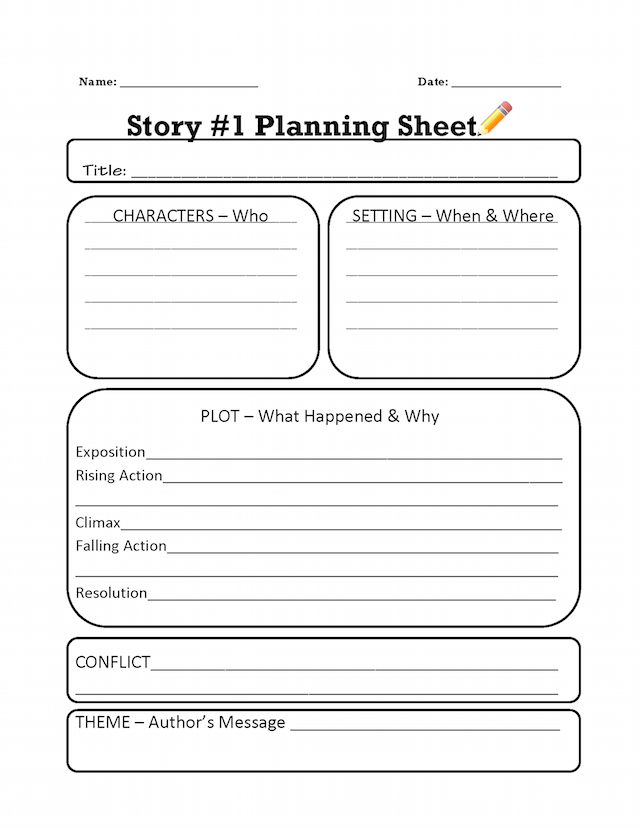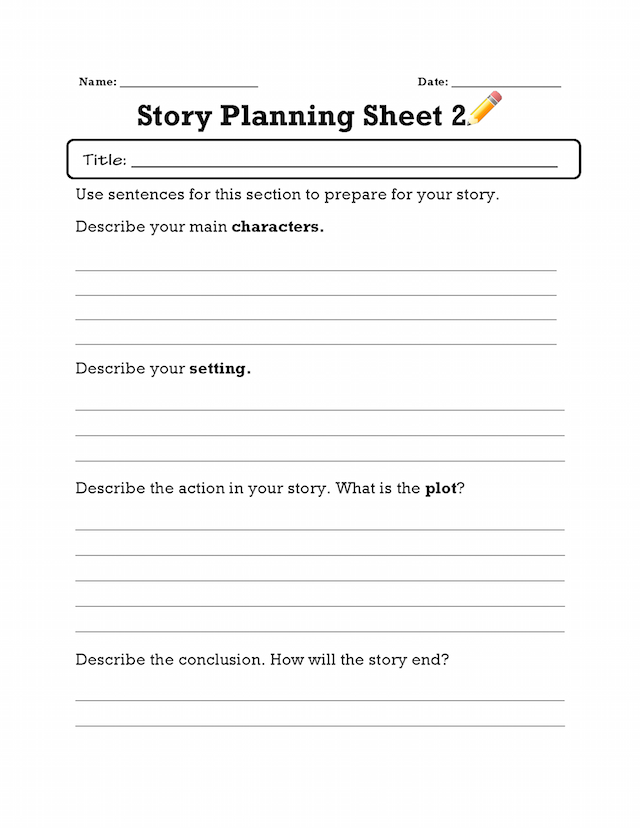2.8 You're the Author - Prewriting
| Site: | Cowichan Valley School District - Moodle |
| Course: | ELA5, CSS, Sferrazza |
| Book: | 2.8 You're the Author - Prewriting |
| Printed by: | Guest user |
| Date: | Wednesday, 7 January 2026, 10:17 PM |
Description
Can you...

Learning Targets
By the end of this lesson, you should be able to say YES to the following questions.
- Can I follow the steps of the writing process to write a short story?
- Can I use my knowledge of the elements of a story to create a good story?
- Can I use my understanding of different genres to write in different genres?
- Can I write engaging and interesting short stories?

You`re the Author
 You are going to try your hand at being a writer! How exciting!
You are going to try your hand at being a writer! How exciting!
You need to pick two different genres to write in. You will be writing two stories. All good things come in pairs!
Tackle one story at a time. If you want, you can use your descriptive writing you submitted in the first Unit as a jumping off point for one of your stories. For each story, use the planning sheets in your Unit Guide.
If you need a refresher on the writing process, revisit this video.
Look at the marking rubric that will be used to assess your work. Look over the marking rubric again before you hand in your final copy.
| Content |
Strong character(s), clear conflict, and theme that are supported by story events and details. Clear beginning, middle and conclusion. |
Characters, conflict, and theme evident, but the supporting information is general. May need a stronger introduction or conclusion. 3 points |
Characters, conflict, and theme are somewhat clear, but there is a need for more supporting information. Introduction and conclusion may be awkward, weak, or missing. |
The story is not clear. There is a seemingly random collection of information. 1 point |
Not submitted 0 points |
| Organization |
The events and details of the story are placed in a logical order and the way they are presented effectively keeps the interest of the reader. |
Events and details are placed in a logical order, but the way in which they are presented/introduced sometimes makes the writing less interesting. |
Some events and details are not in a logical or expected order, OR some details are missing and this distracts the reader. 2 points |
Many events details are not in a logical or expected order. There is little sense that the writing is organized. 1 point |
Not submitted 0 points |
| Word Choice | Writer uses many sensory details, specific nouns, exact verbs, and effective comparisons. 4 points |
Writer uses some sensory details, specific nouns, exact verbs, and effective comparisons. 3 points |
Writer attempts to use sensory details, specific nouns, exact verbs, and effective comparisons. 2 points |
Writer uses almost no sensory details, specific nouns, exact verbs, or effective comparisons. 1 point |
Not submitted 0 points |
| Conventions | Final copy has no errors in punctuation, capitalization, and spelling. 4 points |
Final copy has a few errors, but they don't interfere with understanding the content. 3 points |
Final copy has multiple errors that may make it hard to understand. 2 points |
Work has obviously not been edited or proofread. 1 point |
Not submitted 0 points |
| Writing Process Evidence |
All steps of the writing process included: story planning sheets, plotting action sheets 1-3, conclusion sheet, revised copy, edited copy, and final copy. |
Missing one of the steps of the writing process. 3 points |
Missing more than one of the steps of the writing process. 2 points |
Only one piece of writing handed in. 1 point |
Not submitted 0 points |
Story Writing Tips
Here are some story writing tips.
Brainstorm Story Ideas

Choose the first story genre and now harness in your ideas in the prewriting phase. This is where you get your mental rain cloud to pour out ideas. (Did you see that metaphor!)
Don’t worry about how it looks – just get your pen moving on the paper. There are many different brainstorming techniques. Read through the following pages and find what works best for you.
Free Writing
One way to get started is to set a timer for five to ten minutes and just start writing ideas. Have your topic in mind and keep your words flowing. Don't worry about spelling or grammar; the goal is to get as many ideas as possible down. If you can't think of what to write, just write anything that comes to mind. We won't use this technique this time!
More Brainstorming Ideas
Listing
Write down your topic as the title. Then list as many related ideas underneath it. Write phrases or single words. Your list when brainstorming does not have to be in any kind of order – just list as many things as you can about the topic.
Mind Mapping
Put your story idea in a circle in the middle of the page. Then create branches off it and write down ideas. From these bigger branches, draw smaller branches with related ideas. You can use different colours and add images (quick sketches) to help you with the process.

Choose how you would like to brainstorm. In your Learning Guide, record some ideas. What genres would you like to write stories for? What ideas do you have fo setting? Character? The main type of conflict in each story?
Story Planning Sheet
Now that you have brainstormed ideas, it is time to get planning!
 Go to your Learning Guide and do the Story #1 Planning Sheet.
Go to your Learning Guide and do the Story #1 Planning Sheet.
(You will repeat this process for Story #2 later for all the Learning Guide sheets in this lesson.)
Notice that the Story Planning Sheet looks a lot like the Story Breakdown Sheet. You have had practice breaking down stories for the key elements. This will help you with creating your story! Instead of breaking a story down, you are now constructing one.
You can write in point form and draw simple pictures as you fill out this sheet.

Story Planning Sheet 2
For the Story Planning Sheet 2, put your thoughts into some sentences. See if you can add more details and make your story more interesting. Use your five senses, vivid verbs. and active adjectives. Think back to how you described your monster.
 Go to your Learning Guide and do the Story Planning Sheet 2.
Go to your Learning Guide and do the Story Planning Sheet 2.
